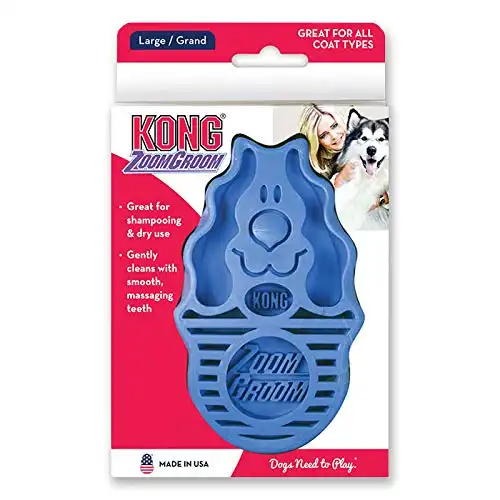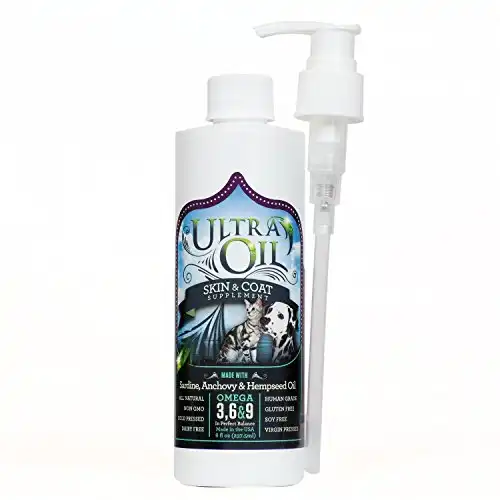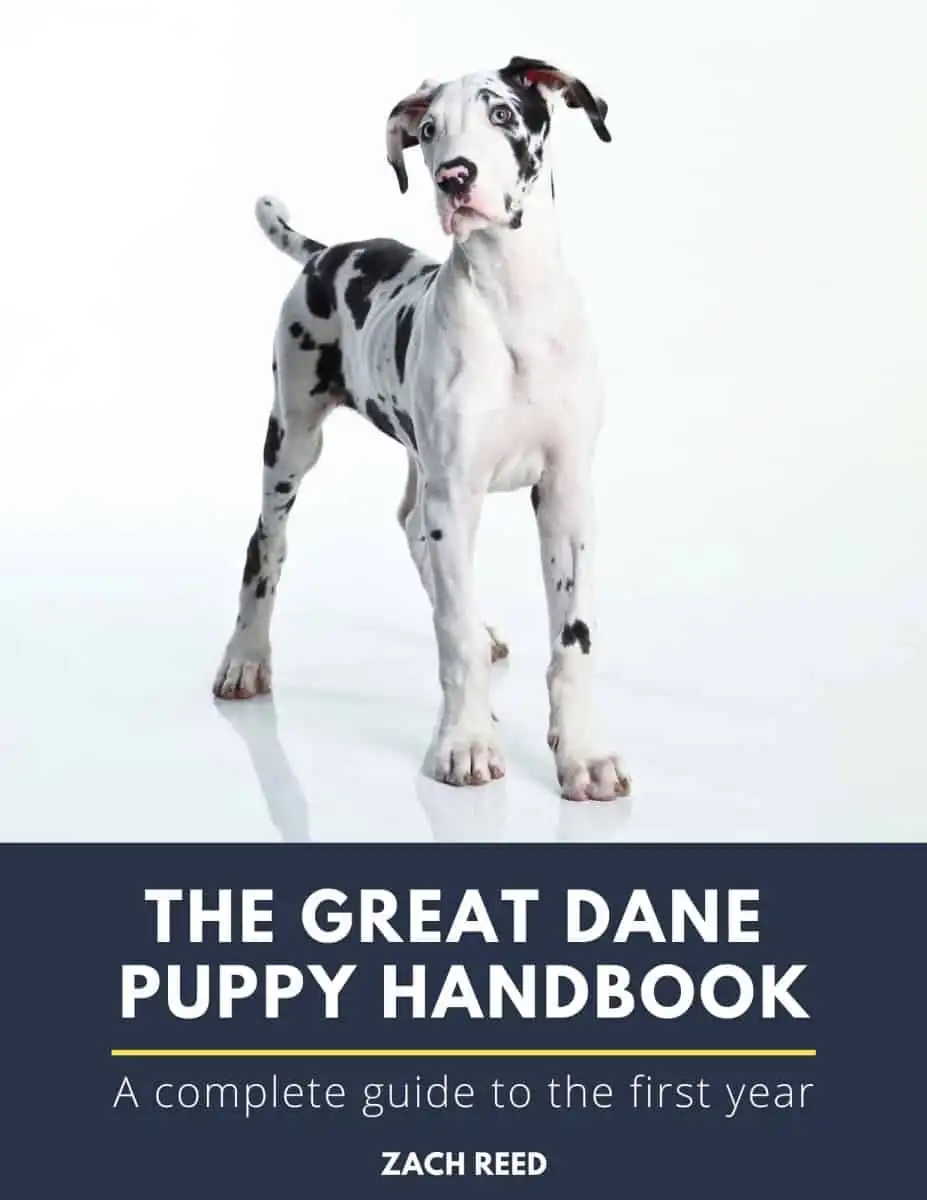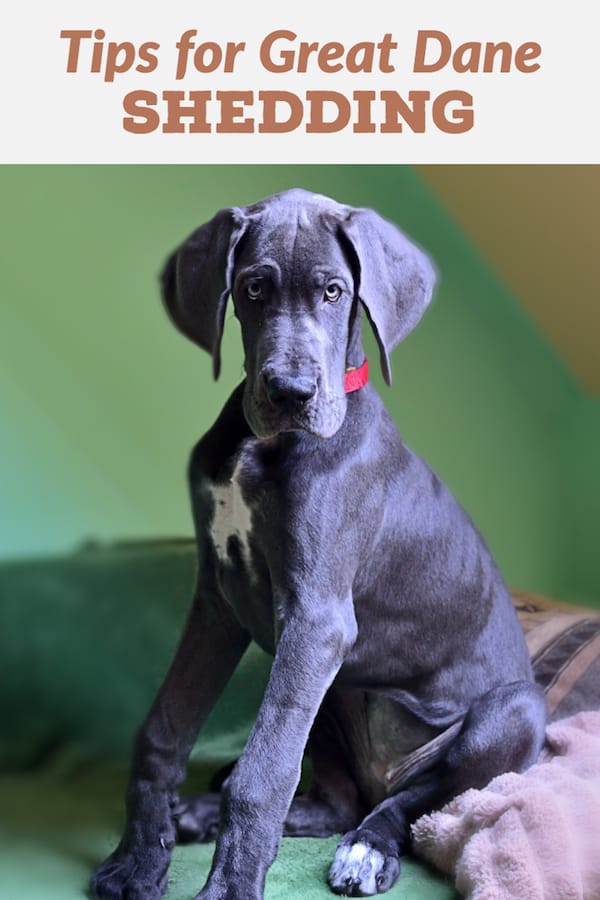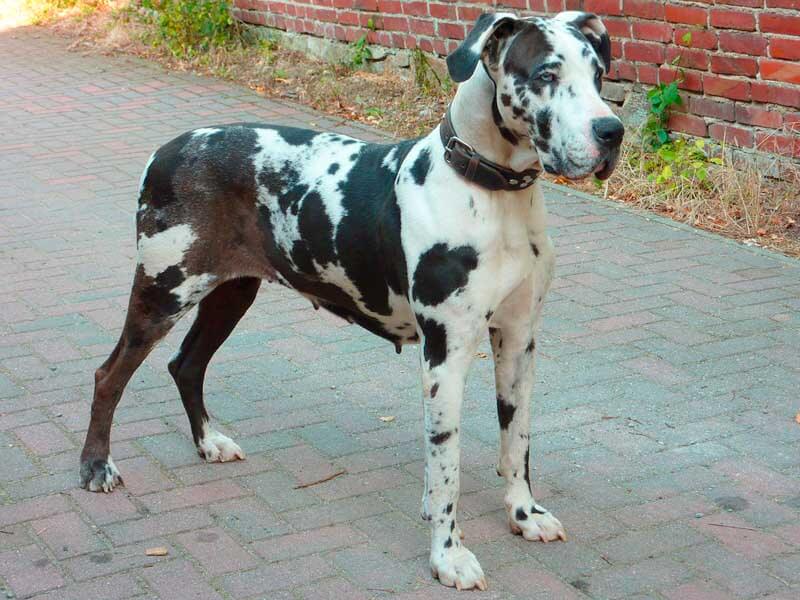
Learn the ins and outs of Great Dane shedding, from understanding their coat patterns to effective grooming techniques. This article offers practical advice to help you minimize shedding and keep your home hair-free!
Great Danes are a moderate-shedding breed, especially during seasonal changes in spring and fall. While their short, thick hair might not seem like it would shed much, regular brushing can help manage the loose hair and maintain the coat’s health.
With just a few minutes each week, you can keep your house clean and your Great Dane’s coat healthy.
Table of Contents
Do Great Danes Shed? Everything You Need to Know
Before jumping straight into the factors that influence shedding, it’s useful to understand some basic info about a Great Dane coat and the natural cycles that it experiences.
Growth Cycle of a Great Danes Coat
A Great Dane’s coat goes through a growth cycle that can last up to two years.
The coat will go through three phases during the growth cycle: anagen, catagen, and telogen.
- The anagen phase is the growth phase, where the hair follicles are active and growing.
- The catagen phase is a transitional phase where the hair follicles start to shrink.
- The telogen phase is a resting phase where the hair follicles are inactive, and the hair is ready to fall out.
Single Coat Vs Double Coat
Great Danes have a single coat, which means they do not have an undercoat.
Although single-coated breeds typically shed less than double-coated breeds, Great Danes can still shed their fair share!
The amount of shedding can vary depending on the individual dog and the season. However, regular grooming can help manage shedding.
Brushing a Great Dane’s coat daily can help remove loose hair and prevent it from ending up all over furniture and floors.
Regular grooming helps manage shedding and also keeps a Great Dane’s coat healthy and shiny!
Great Dane Shedding Explained
Shedding is a natural process that occurs in all dogs, and Great Danes are no exception.
Shedding is the process of losing old or damaged hair to make way for new hair growth.
Shedding Phases
Great Danes go through two shedding phases: natural shedding and seasonal shedding.
Natural shedding is a continuous process that occurs throughout the year. During this phase, Great Danes shed small amounts of hair regularly.
Seasonal shedding, on the other hand, occurs twice a year. Great Danes shed heavily during the spring and fall months to prepare for the changing seasons.
Factors Influencing Shedding
The shedding cycle in Great Danes is influenced by several factors, including genetics, nutrition, health, and the environment.
Genetics plays a significant role in determining the shedding cycle of Great Danes. Some Great Danes may simply shed more than others due to their genetic makeup!
Nutrition is another key factor that can influence the shedding cycle in Great Danes. A healthy diet that is rich in essential nutrients can help maintain healthy skin and coat, reducing excessive shedding.
Health issues such as allergies, infections, and hormonal imbalances can also cause excessive shedding in Great Danes.
The environment can also play a role in the shedding cycle of Great Danes. Changes in temperature and humidity can trigger seasonal shedding.
Additionally, environmental pollutants and toxins exposure can lead to excessive shedding in Great Danes.
Grooming and Shedding
Great Danes are moderate shedders, meaning they shed a reasonable amount of hair throughout the year.
However, they shed heavily during the shedding season, which occurs twice a year.
To keep their coat healthy and shiny, regular grooming is necessary!
Brushing Techniques
Regular brushing is essential for managing shedding and maintaining a healthy coat.
Great Danes should be brushed at least once a week with a gentle brush like the Kong Zoom Groom.
The Zoom-groom is the best grooming and shampooing brush available! It removes loose hair like a magnet, stimulates capillaries, and natural oil production for healthy skin and coats.
Daily brushing can be useful for those prone to allergies during the shedding season.
- Start at the head and work your way down to the tail when brushing.
- Pay attention to the areas where shedding is most common, such as the back, chest, and legs.
- Be gentle when brushing, as Great Danes have sensitive skin and can easily get irritated.
Bathing and Shedding
Great Danes should be bathed every six to eight weeks, depending on their activity level and lifestyle.
Regular bathing is necessary to minimize shedding and maintain healthy skin and coat. When bathing, use a mild dog shampoo and avoid getting water in their ears.
My favorite shampoo for Great Danes is Cloud Star Buddy Wash (link to Amazon).
After bathing, dry them with a towel or a blow dryer on a low setting. Make sure to dry their coat thoroughly to prevent any skin irritation.
During grooming sessions, it’s important to check for any signs of skin irritation, fleas, ticks, or other parasites. If you notice any issues, consult with a veterinarian for proper treatment.
Diet and Shedding
Great Danes require a balanced diet to maintain a healthy coat and prevent excessive shedding.
A poor diet can lead to a dull, brittle coat and increased shedding.
Therefore, providing a high-quality diet that meets their nutritional needs is essential.
Importance of Nutrition
A balanced diet for Great Danes should include high-quality protein, healthy fats, and essential vitamins and minerals.
Protein is essential for maintaining healthy skin and coat, while healthy fats provide omega-3 and omega-6 fatty acids, which help reduce shedding and inflammation.
Some of the best sources of omega-3 fatty acids include fish oil, flaxseed oil, and chia seeds. These supplements can help improve the quality of the coat and reduce shedding.
Additionally, incorporating fruits and vegetables into their diet can provide essential vitamins and minerals that support overall health and a healthy coat.
Supplements for A Healthy Coat
Supplements can also be beneficial in reducing shedding and promoting a healthy coat. Omega-3 fatty acid supplements are particularly effective in reducing shedding and improving coat quality.
Skin and coat irritations often result from deficiencies in a pet’s diet. Our special formula provides the Omega fatty acids pets need for healthy skin and a shiny coat.
Other Great Dane supplements that can be beneficial include biotin, zinc, and vitamin E.
It is important to note that supplements should not be used as a replacement for a balanced diet.
Rather, they should complement a high-quality diet to ensure that Great Danes receive all the essential nutrients they need to maintain optimal health and a healthy coat.
By providing high-quality protein, healthy fats, and essential vitamins and minerals and incorporating supplements where necessary, owners can help their Great Danes maintain a healthy and shiny coat.
Other Factors Affecting Shedding
Aside from breed, there are other factors that can affect how much a Great Dane sheds.
These factors include size, stress, body temperature, exercise, and daylight hours.
1. Size
Great Danes are a large breed, and as such, they have a lot of surface area to shed from.
This means they can still shed a lot even if they don’t have a particularly thick coat.
Additionally, larger dogs tend to shed more than smaller dogs, so the size of a Great Dane can also contribute to their shedding.
2. Stress
Stress can cause a dog to shed more than usual. This is because stress can affect the dog’s immune system, which can, in turn, affect their skin and coat health.
If a Great Dane is going through a stressful period, such as a move or a change in routine, they may shed more than usual.
3. Temperature
Temperature can also affect how much a Great Dane sheds.
Dogs shed their coat to regulate their body temperature, so if a Great Dane is too hot or too cold, they may shed more than usual.
Dogs tend to shed more in the spring and fall as they adjust to changing temperatures.
4. Body Temperature
A Great Dane’s body temperature can also affect its shedding.
If a Great Dane has a fever or is otherwise unwell, it may shed more than usual as its body tries to regulate its temperature.
5. Exercise
Exercise can play a role in how much a Great Dane sheds. Regular exercise can help keep a dog’s skin and coat healthy, which can reduce shedding.
On the other hand, if a Great Dane is not getting enough exercise, they may shed more than usual as their skin and coat health suffers.
6. Daylight Hours
Finally, daylight hours can also affect how much a Great Dane sheds. Like many animals, dogs have a natural shedding cycle influenced by daylight hours.
As the days get shorter in the fall and winter, dogs may shed more as their bodies prepare for the colder months.
While the breed is the biggest factor in how much a Great Dane sheds, other factors such as size, stress, temperature, body temperature, exercise, and daylight hours can also play a role.
By understanding these factors, Great Dane owners can take steps to minimize shedding and keep their dogs healthy and happy.
Great Danes vs Other Breeds
Shedding Comparison
Great Danes are moderate shedders compared to other dog breeds. While they may shed less fur than double-coated dogs, they still shed frequently.
Owners should be prepared to deal with some level of shedding.
Poodles, on the other hand, are known for being hypoallergenic and low-shedding dogs. Their curly coats trap hair and dander, preventing it from spreading around the house.
This makes them a great choice for people with allergies or those who want a dog that sheds less.
It is important to note that not all double-coated dogs shed excessively.
Some breeds, such as the Siberian Husky, have a dense undercoat that sheds heavily twice a year, but their topcoat sheds minimally.
Overall, it is difficult to generalize shedding among dog breeds. Factors such as coat type, size, and individual genetics all play a role in how much a dog will shed.
However, it is safe to say that Great Danes are moderate shedders compared to other breeds, and owners should be prepared to deal with some level of shedding.
Fur Loss vs Excessive Shedding
While all dogs naturally shed, there could be cause for concern if you notice actual fur loss.
Some infections and illnesses will result in the formation of hairless patches, while others will result in an overall reduction of the volume of their coat.
This should be easily distinguishable from normal shedding regardless of the season due to the appearance and feel of their coat.
Common signs to look for include:
- Bald patches or missing clumps of hair
- Hair that breaks or falls out unevenly
- The coat is dry and brittle to the touch
- Skin rashes or other skin issues
It is possible that these changes are a result of changes in diet, allergic reactions to shampoo or medications, hormonal fluctuations (including pregnancy), or increased stress.
To be certain, you should take your Great Dane to the veterinarian for further diagnosis.
This is another reason why brushing as part of your Great Dane’s regular grooming routine is important, as it will keep you in tune with changes to its coat.
Dandruff in Great Danes
It’s almost impossible to talk about Great Dane coat maintenance without touching on dandruff. Due to their sensitive skin, dandruff can be common among Great Danes.
In some cases, dandruff is caused by bathing too frequently or using a shampoo that is too harsh for the skin. If reducing their bath frequency and shampoo brand does not resolve the issue, then the source is obviously elsewhere.
Poor diet is another leading cause of both dandruff and poor coat appearance. You may want to consider switching to a higher quality brand of food or looking into a RAW diet to improve the health of their skin and coat.
Keep in mind that it will take them at least a few weeks to adapt to any new food regimens, so don’t expect an immediate result.
Others have found that the addition of an omega fatty acid (link to a great one on Amazon) greatly improves the quality of their Great Danes’ skin and coat.
However, my preference would always be to try and address their overall diet and other external factors first before jumping straight to dietary supplementation.
Lastly, known endocrine disorders such as Cushing’s disease and hyperthyroidism have also been known to cause dandruff.
If you weren’t able to resolve their dandruff via dietary changes or grooming habits, then it could be worth a trip to the vet to see if it’s something more alarming.
Great Dane Shedding FAQs
What is the shedding frequency of Danes?
Great Danes are a moderate-shedding breed, so it’s normal for them to shed a lot. The amount of shedding can vary depending on the dog, but Great Danes typically shed twice a year during seasonal changes.
During these times, they will shed their undercoat to prepare for the upcoming season. However, they may also shed moderately throughout the year due to various factors such as stress, diet, and health issues.
HOW DO I STOP MY DANE FROM SHEDDING?
It’s impossible to completely stop a Great Dane from shedding, but there are ways to minimize the amount of hair they shed. Regular grooming is essential to keep their coat healthy and reduce shedding.
Brushing their coat at least once a week with a slicker brush or a deshedding tool can help remove loose hair and prevent matting. Bathing them every 2-3 months can also help remove loose hair and keep their coat clean and healthy.
In addition, providing a healthy diet with essential fatty acids can improve the quality of their coat and reduce shedding. Omega-3 and Omega-6 fatty acids found in fish oil and flaxseed oil can help improve the condition of their skin and coat.
Ensuring they have access to plenty of fresh water can also help keep their coat healthy and reduce shedding.
Overall, managing Great Dane shedding can be challenging, but with proper grooming and diet, it can be minimized to a manageable level.
We hope that you found this information helpful. Before you go, make sure to take a look at our favorite products for Great Danes!
The Great Dane Puppy Handbook takes all of the need-to-know Great Dane info and packages it together into a single, concise resource. Save yourself time, money, and frustration by avoiding the most common mistakes made by Great Dane owners!

